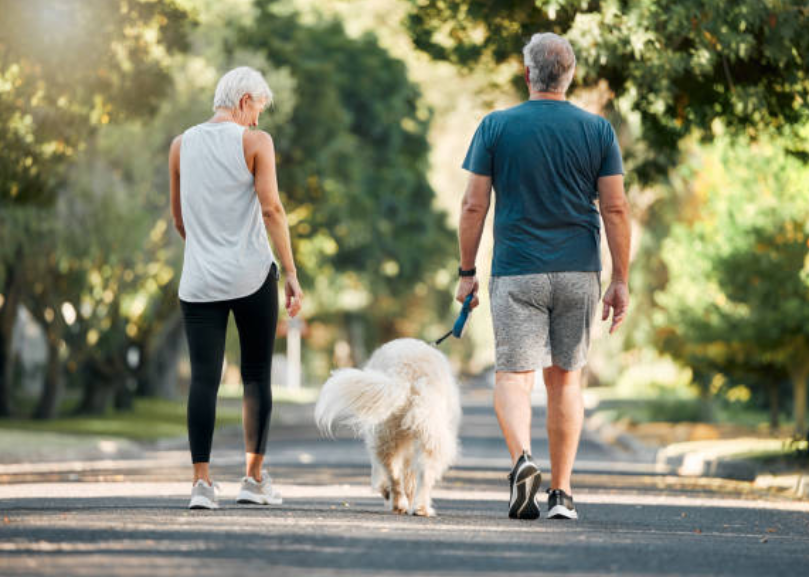
I understand that as a physical therapist, your goal is to return to your normal routine after surgery. One activity that you particularly miss is walking your dog.
The happiness of going outside with your furry friend is priceless and a crucial part of your healing process. This article is about walking dogs after surgery. We will look at how to safely start doing this again.
Timeline to Start Walking Your Dog Post-Knee Replacement Surgery
Knee replacement recovery is a journey of incremental steps. Understanding the timeline of recovery helps patients better navigate their path to regaining mobility.
Depending on your progress and your healthcare team's specific instructions, the timeline for resuming dog walking varies. After knee surgery, start by resting. As you become stronger and more mobile, gradually incorporate short, supervised walks into your physical rehabilitation routine.
Guidelines for Walking Your Dog After Knee Replacement Surgery
Walking your dog post-surgery is not merely about picking up the leash and heading out the door. There are crucial knee surgery precautions to follow to ensure safety and effectiveness. Start with short walks and gradually increase the duration and intensity as your strength improves.
Incorporating safe exercises after knee replacement into your dog walks can also be beneficial. These might include gentle stretching or slow-paced walking exercises to enhance flexibility and muscle strength.
Knee Surgery Precautions While Walking Your Dog
Safety is paramount during this delicate recovery phase. Patients must be aware of potential risks, such as falls or sudden movements that can put undue stress on the knee. Make sure to wear supportive footwear, maintain awareness of your surroundings, and practice controlled movements. Avoid uneven surfaces and stay vigilant for potential trip hazards, ensuring your path is clear and safe.
The Role of Physical Rehabilitation Post-Knee Surgery in Dog Walking
Physical therapy after knee surgery is important for regaining movement and strength, making it necessary for your recovery. Specific post-surgical mobility exercises can prepare you for the physical demands of dog walking, improving stability and balance over time. After surgery, physical therapists suggest balance exercises to make your lower body and core stronger, improving stability and control when walking.
Use of Supportive Leash to Minimize Strain
Choosing the right leash is an often-overlooked aspect of dog care after an owner's surgery. A strong leash can help you control your dog better, preventing sudden pulls or twists that could hurt your knee. Teach your dog to walk calmly beside you and discourage pulling on the leash for a safe and enjoyable walk.
Walking 'Tucker': A Case Study
To put these guidelines into context, let's take a practical example of 'Tucker', a patient’s energetic labrador retriever. After Tucker's owner underwent knee replacement surgery, they followed the knee replacement therapy guidelines we provide at Be On The Move.
The owner initially started with short walks in the backyard, ensuring Tucker was on a supportive leash. As weeks passed, they gradually increased the distance, always cautious of maintaining proper balance and control. With time, the owner successfully walked Tucker in the park, thanks to planning and therapy.
Conclusion: Benefits of Dog Walking Post-Surgery. Balance exercises post-surgery
Dog walking post-surgery is not only a step towards normalcy but also an integral part of knee replacement recovery. It provides physical benefits, such as improved strength and balance, as well as mental benefits like stress reduction and mood improvement. Follow knee surgery precautions and guidance from healthcare professionals to enjoy walking with your loyal companion again.
The journey to recovery is unique for everyone, so it's essential to seek personalized advice from your healthcare provider or a professional physical therapy service like Be On The Move. We wish you a successful recovery and a return to the happiness that dog walking brings. Let your path to recovery be one of strength, perseverance, and newfound mobility.
See you soon,
//❤️ Trudy//
Disclaimer: The information provided in this blog post is for educational purposes only and is not intended as medical advice. Every individual's situation is unique, and the content may not apply to your specific circumstances. Always consult with your healthcare provider for personalized advice before starting any new exercise or treatment plan. Be On The Move encourages all readers to maintain regular appointments with their doctors and to discuss any questions they may have about their conditions or any other health concerns.
Navigating the Post-Knee Replacement Journey with Your Dog
by Trudy Diraj on 2023-07-17
Experience top-quality in-home care
Book a Visit
Be On The Move
In-Home Physical Therapy
Be On The Move is the leading provider of in-home physical therapy in Florida. We proudly deliver exceptional care to hundreds of patients, helping them regain mobility and independence in the comfort of their own homes.

Trudy D
PT
Trudy D is a highly skilled physical therapist with extensive clinical experience in outpatient orthopedic and neurological disorders. Her comprehensive background underscores her deep clinical knowledge and commitment to exceptional patient care.

